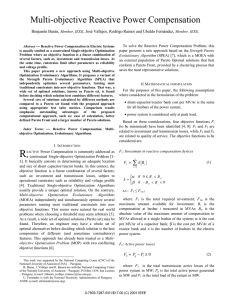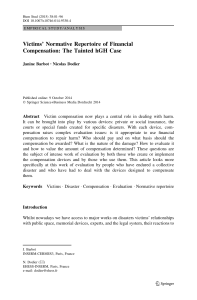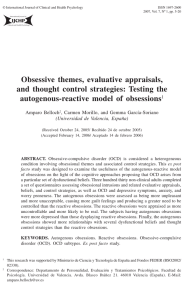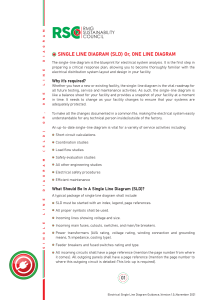Document
Anuncio
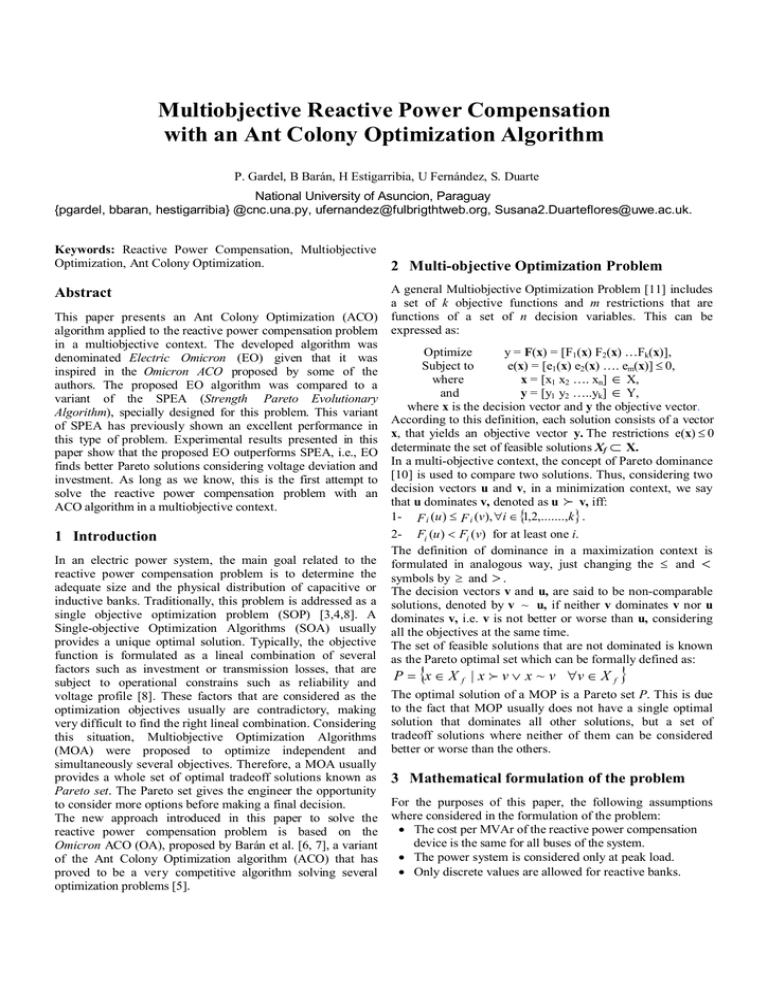
Multiobjective Reactive Power Compensation
with an Ant Colony Optimization Algorithm
P. Gardel, B Barán, H Estigarribia, U Fernández, S. Duarte
National University of Asuncion, Paraguay
{pgardel, bbaran, hestigarribia} @cnc.una.py, [email protected], [email protected].
Keywords: Reactive Power Compensation, Multiobjective
Optimization, Ant Colony Optimization.
Abstract
This paper presents an Ant Colony Optimization (ACO)
algorithm applied to the reactive power compensation problem
in a multiobjective context. The developed algorithm was
denominated Electric Omicron (EO) given that it was
inspired in the Omicron ACO proposed by some of the
authors. The proposed EO algorithm was compared to a
variant of the SPEA (Strength Pareto Evolutionary
Algorithm), specially designed for this problem. This variant
of SPEA has previously shown an excellent performance in
this type of problem. Experimental results presented in this
paper show that the proposed EO outperforms SPEA, i.e., EO
finds better Pareto solutions considering voltage deviation and
investment. As long as we know, this is the first attempt to
solve the reactive power compensation problem with an
ACO algorithm in a multiobjective context.
1 Introduction
In an electric power system, the main goal related to the
reactive power compensation problem is to determine the
adequate size and the physical distribution of capacitive or
inductive banks. Traditionally, this problem is addressed as a
single objective optimization problem (SOP) [3,4,8]. A
Single-objective Optimization Algorithms (SOA) usually
provides a unique optimal solution. Typically, the objective
function is formulated as a lineal combination of several
factors such as investment or transmission losses, that are
subject to operational constrains such as reliability and
voltage profile [8]. These factors that are considered as the
optimization objectives usually are contradictory, making
very difficult to find the right lineal combination. Considering
this situation, Multiobjective Optimization Algorithms
(MOA) were proposed to optimize independent and
simultaneously several objectives. Therefore, a MOA usually
provides a whole set of optimal tradeoff solutions known as
Pareto set. The Pareto set gives the engineer the opportunity
to consider more options before making a final decision.
The new approach introduced in this paper to solve the
reactive power compensation problem is based on the
Omicron ACO (OA), proposed by Barán et al. [6, 7], a variant
of the Ant Colony Optimization algorithm (ACO) that has
proved to be a very competitive algorithm solving several
optimization problems [5].
2 Multi-objective Optimization Problem
A general Multiobjective Optimization Problem [11] includes
a set of k objective functions and m restrictions that are
functions of a set of n decision variables. This can be
expressed as:
Optimize
y = F(x) = [F1(x) F2(x) …Fk(x)],
Subject to
e(x) = [e1(x) e2(x) …. em(x)] ≤ 0,
where
x = [x1 x2 …. xn] ∈ X,
and
y = [y1 y2 …..yk] ∈ Y,
where x is the decision vector and y the objective vector.
According to this definition, each solution consists of a vector
x, that yields an objective vector y. The restrictions e(x) ≤ 0
determinate the set of feasible solutions Xf ⊂ X.
In a multi-objective context, the concept of Pareto dominance
[10] is used to compare two solutions. Thus, considering two
decision vectors u and v, in a minimization context, we say
that u dominates v, denoted as u f v, iff:
1- F i (u ) ≤ F i (v ), ∀i ∈ {1,2,......., k } .
2- Fi (u ) < Fi (v) for at least one i.
The definition of dominance in a maximization context is
formulated in analogous way, just changing the ≤ and <
symbols by ≥ and > .
The decision vectors v and u, are said to be non-comparable
solutions, denoted by v ~ u, if neither v dominates v nor u
dominates v, i.e. v is not better or worse than u, considering
all the objectives at the same time.
The set of feasible solutions that are not dominated is known
as the Pareto optimal set which can be formally defined as:
P = {x ∈ X f | x f v ∨ x ~ v ∀v ∈ X f }
The optimal solution of a MOP is a Pareto set P. This is due
to the fact that MOP usually does not have a single optimal
solution that dominates all other solutions, but a set of
tradeoff solutions where neither of them can be considered
better or worse than the others.
3 Mathematical formulation of the problem
For the purposes of this paper, the following assumptions
where considered in the formulation of the problem:
• The cost per MVAr of the reactive power compensation
device is the same for all buses of the system.
• The power system is considered only at peak load.
• Only discrete values are allowed for reactive banks.
• The maximum sizes of reactive and capacitive banks are
imposed.
Based on these assumptions, two objective functions were
selected to be minimized: investment related to the reactive
power compensation device and average voltage deviation.
3.1 Objective functions
The two selected objective functions (F1, F2) can be
formulated as follows:
F1: Invest in reactive power compensation device:
n
F1 = ∑ Bi
i =1
0 ≤ F1 ≤ F1m
s.t .
0 ≤ Bi ≤ Bm
(1)
where: F1 is the total required invest; F1m is the maximum
amount available for investment; Bi is the compensation at
busbar i, measured in MVAr; Bm is the absolute value, in
MVAr, of the maximum amount of compensation allowed at
a single busbar of the system and n is the number of busbar in
the electric power system.
F2: Average voltage deviation:
n
F2 =
∑V
*
i
− Vi
(2)
i =1
n
where: F2 is the per unit (pu) average voltage difference;
Vi is the actual voltage at busbar i (pu) and Vi * is the desired
voltage at busbar i.
3.2 Description of the solution representation and the
search space.
A solution of the problem is a distribution of the reactive
power compensation devices that satisfies the economic and
operative restrictions. This solution is represented by a vector
x = B of dimension n where each entrance bi associates a
value of reactive compensation to busbar i.
For example, considering a three busbar system, x = [-2, 0, 3]
represents a solution where the first busbar has a reactor of 2
MVAr, the second busbar is not compensated and the third
busbar has a capacitor of 3 MVAr. Then, for a solution x, the
load distribution and the load flow equations determine an
objective vector y = [F1(x), F2(x)].
In real life, the commercial availability of reactive power
compensation devices limit the number of possible
compensation values that can be considered for each busbar.
This number of possible compensations available for a busbar
is denoted by c. Thus, a vector o f c possible compensation
levels may be defined for each busbar i as Bi =
[bi1,….bij,….,bic]. For the sake of simplicity, the same value of
c was adopted for every busbar.
modifications were introduced to the original SPEA algorithm
to improve its performance in the reactive power
compensation problem, as: a heuristic initialization; a local
optimization heuristic technique; two external populations to
store the solutions and a technique inspired in Simulated
Annealing, known as Freezing. The method proposed by
Barán et al. [1,2,9] may be summarized in the following
steps:
1. Generation of an initial population Pop, using the heuristic
method exposed in [1,2,9] and the creation of two empty
external nondominated sets Pknown and SPknown (stored
external populations)
2. Copy the nondominated members of Pop to Pknown and
SPknown.
3. Remove individuals within SPknown, wh i ch are
dominated by any member of SPknown.
4. Remove solutions within Pknown, wh i ch are dominated
by any member of SPknown.
5. If the number of solutions in Pknown exceeds a given
maximum g, clustering is applied in order to reduce the
external population to a size g.
6. Calculate the fitness of each individual in Pop as well as
in Pknown using standard SPEA fitness assignment
procedure.
7. Select individuals from Pop + Pknown (multiset union) until
the mating pool is filled.
8. Apply the probabilities Pto (using the local optimization),
Pc (crossover) and Pm (mutation) to determinate whether
an individual is locally optimized or selected for crossover
and mutation, in which case, standard genetic operators
are applied.
9. In case the stop criterion is not verified go to step 2.
5 Proposed method: Electric Omicron (EO).
Ant Colony Optimization Algorithms (ACO) are inspired in
the behavior of real ant colonies [5]. Real (biological) ants
communicate to each other in an indirect way using a
chemical substance called pheromone. In a similar way,
artificial ants, created by an ACO algorithm, communicate to
other artificial ants using a matrix τ = {τ ij }, called
pheromone matrix. The pheromone matrix summarizes in
some way the information already found by former ants
guiding new ants to construct potentially good solutions. ACO
algorithms also take advantage of heuristic information η
called visibility. The visibility used in this paper was
especially defined for the reactive power compensation
problem and it is explained in subsection 5.1.
An artificial ant uses the information saved in τ and the
visibility η to construct potentially good solutions, traveling
around all busbars of the power system. At each busbar i
an ant determine a probability of selecting a compensation bij
for that busbar i using the following equation:
4 SPEA description.
The algorithm used for comparison was originally proposed
by Barán et al. [1] and later improved in [2]. It was inspired in
the already well-established SPEA [11]. Several
Pr ij
α
β
τ ij × η ij
=
β
α
∑ τ ij × η ij
(3)
where α and β define the relative influence of the
heuristic information and the pheromone level.
Once the probability for every bij has been determined, a
probabilistic selection method, like a roulette wheel [2], is
used to choose a specific value considering the probabilities
associated which each compensation value. The same
procedure is applied to determinate the compensation at every
busbar of the power system.
All the nondominated solutions are saved in a set known as
population Pop. Every time a new solution is generated, it is
compared to the ones in Pop. If the new solution is
nondominated witch respect to Pop it is kept, otherwise it is
dismissed.
This iterative process is repeated K times. Then τ is updated
witch the m solutions saved in Pop. The parameter O
(Omicron) defines the amount of pheromone that each
solution deposits.
The pheromone matrix associates a row vector to each busbar
and a column to every possible compensation bj. In the
updating process, all entrances in τ are firstly settled to an
initial value τ 0 . In order to updateτ , an artificial ant follows
the following steps:
1- Take a solution of Pop.
2- Check the value bij of the compensation device settled in
busbar i.
3- Deposit an amount of O/m pheromone at the column of
τ associated to bj in the row i ofτ .
4- Repeat steps 2 and 3 for every busbar in the system.
5- Repeat steps 1 to 4 for every solution in Pop.
As a consequence, the entrances in τ only take values
between τ 0 and O +τ . The proposed EO algorithm
continues this process until a stop condition is reached.
busbar and a column to every possible compensation bj. This
matrix assign a probability of been selected to every
considered bj for each busbar. The assignment of probability
is made according to the compensation needed in each busbar.
So, if inductive compensation is needed the probability grows
giving low levels of probabilities of being selected to the
capacitive banks and high levels to the capacitive banks (see
Fig. 1). The maximum probability assigned to the largest
capacitive (or inductive) bank is directly proportional to the
voltage deviation in each busbar.
The second function, η , guides the ants to construct solutions
with low level of compensation, that is, η prioritizes the
minimization of investment over the voltage deviation. To
achieve its goal, η assigns a low probability of being
selected to the banks of great value, capacitive or inductive,
and a high probability to small banks and to the null
compensation, as shown in Fig. 2.
Finally, η and η are linearly combined to define visibility:
2
2
2
1
2
η [ij ] = w1 *η1 [ij ] + w2 *η 2 [ j ]
where w1 and w2 are weight factors (with w1 + w2 = 1)
that change with the iterations of the algorithm, i.e., w1 is
initialized in 1 and w2 in 0; then, w1 dynamically decreases
with the number of iterations until it reaches a final value of
0, when w2 reaches a value of 1.
Reactive Compensation
Probabilities
level by η1
Inductive
5.1 Visibility
In a single objective context the visibility usually guides the
ant to make what seems to be the locally best choice. But, in a
multi-objective context is not always possible to determinate
the locally best choice because the different objectives may
be contradictory among them. So, for the present work, to
reduce the voltage deviation the power compensation should
be increase and, for other side, to minimize the invest, the
power compensation should decrease. Clearly, there is not a
unique locally best choice that satisfies both objectives.
Based on this kind of tradeoff considerations, two different
functions were created and combined to define the visibility.
Both functions “guide” the ants assigning probabilities to
every possible compensation, bj, at each busbar.
To determinate visibility, a load flow solution is first
calculated considering the network with a base compensation
distribution, for this paper the visibility is calculated
considering the system with no reactive compensation at all.
Based on this load flow results, visibility η is defined as a
linear combination of two functions: 1η and η .
The first function, η , guides the ants to construct good
solutions with high compensation values; therefore, with a
low voltage deviation. For this purpose, the function η
creates a matrix, similar to τ , that associates a row to every
1
2
1
1
(4)
Null
Capacitive
Figure 1: Graphic representation of probabilities assigned byη 1 , in
this case inductive compensation is needed.
Reactive Compensation
Probabilities
level by η 2
Inductive
Null
Capacitive
Figure 2: Graphic representation of probabilities assigned by η 2 ,
where null compensation has higher probability.
At the beginning of a run, η assigns probability levels very
similar to the figure 1, while at the end, the probability
distribution looks like figure 2. At an intermediate iteration
with w1 = w2 = 0.5, the distribution of probabilities would
look like the one shown in figure 3.
Reactive Compensation
Probabilities
level by η at a
intermediate
iteration
Inductive
Null
Capacitive
Figure 3: Graphic representation of probabilities assigned by η at an
intermediate iteration of generation.
With the utilization of this combined visibility that is
changing dynamically we aim to achieve the construction of
solutions with high compensation at the beginning of a
generation and solutions with low compensation level at the
final of the generation.
To compare experimental results, the concept of coverage,
is used [2,11]. Given two set of solution, C 1 and C 2 , the
coverage of C 1 over C 2 can be defined as fallows:
(C1,C2)=
{y' '∈ C ; ∃ y'∈ C
2
1
C2
5.2 Electric Omicron (EO) pseudocode.
A brief pseudocode corresponding to the proposed Electric
Omicron (EO) may be expressed as follows:
Read load network parameters.
Randomly, generate initial population
Calculate 1η and η (visibility functions).
While end condition is not reached
Update pheromone matrix τ
For k=1 to K
Calculate visibility η .
Ant creates a new solution Snew.
Evaluate Snew. (Calculate objective functions)
If Snew is non-dominated (it is a good solution)
POP =POP + Snew
else
Discard Snew.
end if
end for
Eliminate dominated solution from POP.
end while.
1
2
6 Experimental Results.
In order to compare the proposed EO algorithm to the already
established SPEA of Barán et al. [1,2], ten runs of each
algorithm were performed. A unique initial population was
created and utilized for all runs of the algorithms. This initial
population was generated using the heuristic method proposed
in [1,2].
The well-known IEEE 118 power system [1,2] is used as a
test problem for this paper to facilitated comparison.
For the SPEA algorithm, two sets of five runs each were
made. For the first set, 120 generations and 100 individuals
were determined, following the suggestions of Barán et al
[1,2]. This first set of executions took about 8 hours each.
The second set was determined to take twice as long, i.e. it
took about 16 hours, and evaluated 230 generations.
In a similar way, two sets of five runs were made with the EO
algorithm, taking about 8 hours and 16 hours respectively.
The EO algorithm created and evaluated 10,000 solutions in
the 8 h o u r s executions set and 20,000 solutions for the
sixteen hours executions set. The parameters f o r t h e
pr oposed h eur istic wer e ar bitrated and
s e t t l e d K = 1000 and O = 1500.
Thus, the following Pareto sets were calculated:
S1
for 5 runs of the SPEA, in about 8 hours
S2
for 5 runs of the SPEA, in about 16 hours
Sf
for the SPEA, combining S1 and S2
EO1
for 5 runs of the EO, in about 8 hours
EO2
for 5 runs of the EO, in about 16 hours
EOf
for the EO, combining EO1 and EO2
}
s.t. y ' f y ' '
*100
(5)
The coverage value, (C1,C2), indicates the percentage
of solution of th e second set that is dominated by at
least one solution of the first set.
In Table 1 the coverage values of SPEA over EO are shown.
It indicates that almost none solution of a set calculated
using EO is dominated by any solution found by the SPEA
algorithm. At the same time, t h e c o v e r a g e v a l u e s
o f O E o v e r S P E A s h o w n i n t a b l e 2 indicate
that m o s t solutions calculated with SPEA are dominated
by at least one solution found by the EO.
Clearly, Tables 1 and 2 shows that EO solutions are better than
the ones calculated with SPEA, most of the time. In fact, no
solution of set EO2 is dominated by any solution calculated
with SPEA (see second row of Table 1). On the contrary,
every solution of S1 is dominated by at least one solution of
any set calculated with the proposed EO algorithm.
(S, EO)
EO1
EO2
EOf
S1
0%
0%
0%
S2
1,2%
0%
0%
(EO, S)
S1
S2
Sf
EO1
100%
98,2%
98,2%
EO2
100%
100%
100%
Sf
1,2%
0%
0%
Table 1: Coverage of SPEA over EO, (S, EO).
EOf
100%
100%
100%
Table 2: Coverage value of EO over SPEA, (EO, S).
Figure 4 compares the Reactive Power Compensation
measured in MVA vs. the Average Voltage in pu, for a run of
eight hours of EO and SPEA. Figure 5 shows the same
parameters for the sixteen hours execution.
Figure 4: Total reactive power compensation (X-axis) vs. average
voltage deviation (Y-axis) for EO and SPEA, after 8 run hours.
it becomes better known to electrical engineers, given the
excellent experimental results that have already been
reported in the specialized literature.
References
[1] Barán B., Vallejos J., Ramos R. and Fernández U.,
"Multi-Objective Reactive Power Compensation" in
Proc. IEEE Transmission and Distribution Conference
and Exposition, Atlanta, USA. 2001.
Figure 5: Total reactive power compensation (X-axis) vs. average
voltage deviation (Y-axis) for EO and SPEA after 16 run hours.
Clearly, EO outperforms the SPEA algorithm finding better
solutions, i.e. EO finds solutions with lower investment than the
solutions found by the SPEA algorithm, for similar average
voltage deviation.
Conclusion and future work.
This paper presents the Electric Omicron algorithm, a
specialized version of the Omicron ACO to solve the reactive
power compensation problem. As long as we know, this is the
first time an Ant Colony Optimization algorithm is used to
solve this problem in a multiobjective context.
In order to apply the Omicron ACO to the reactive power
compensation problem a new visibility function was
specially designed, combining dynamically two different
probability distribution with the aim of obtaining a better set
of Pareto solutions in only one run of the EO. Each
probability distribution is chosen to improve one of the
conflicting objective functions: investment in reactive devices
and average voltage deviation.
Analyzing the experimental results we concluded that the
Electric Omicron is a novel promising alternative to solve
reactive power compensation problem. The proposed EO
algorithm clearly presents a better performance than the
specialized SPEA, one of the most competitive algorithms for
this problem [2]. As a matter of fact, the solutions found by
the EO algorithm completely dominate the solutions found by
the SPEA for the test problem (IEEE-118). This is even
more worthy considering that these results have been
accomplished by the EO algorithm without any refinement
or local search algorithm like the ones used with the SPEA
algorithm.
In future works the EO algorithm will be tested with more
objective functions as power lose and maximum voltage
deviation, for other test problems of different complexity and
the value of possible compensation consider for each busbar
will be limited to included only commercial compensation
devices.
At the same time, the EO algorithm m a y b e modified to
include several pheromone matrixes; with this we expect to
achieve better Pareto sets with more objectives. Finally, we
foresee other interesting applications of ACO algorithms after
[2] Barán B., Vallejos J., Ramos R. and Fernández U.,
"Reactive Power Compensation using a Multi-Objective
Evolutionary Algorithm" in Proc. IEEE
Porto
PowerTech'2001. Porto, Portugal. 2001.
[3] Carlisle J., El-Keib A., Boyd D. and Nolan K., “A
Review of Capacitor
Placement Techniques on
Distribution Feeders” in Proc. IEEE 29º Southeastern
Symposium on System Theory (SSST’97). 1997.
[4] Delfanti M., Granelli G., Marannino P. and Montagna
M., “Optimal Capacitor Placement Using Deterministic
and Genetic Algorithms” IEEE Trans. Power System,
vol. 15, nº3, pp. 1041-1046, August 2000.
[5] Dorigo M.
Optimization
Dorigo and
Optimization,
and Di Caro G., “The Ant Colony
Meta-heuristic” Ei David Corne, Marco
Fred Glover, editors, New Ideas in
pages 11-32. McGraw-Hill, London, 1999.
[6] Gomez O. and Barán B., “Arguments for ACO’s
Success”, Osvaldo Gomez and Benjamín Barán. Lecture
Notes in Computer Science (LNCS). Springer-Verlag.
Genetic and Evolutionary Computing Conference
(GECCO 2004). Seattle, United States. 2004.
[7] Gomez O. and Barán B., “Reasons of ACO’s Success in
TSP” Lecture Notes in Computer Science (LNCS).
Springer-Verlag. ANTS 2004 Conference. Brussels,
Belgium. 2004.
[8] Miu K., Chiang H. and Darling G., “Capacitor
Placement, Replacement and Control in Large-Scale
Distribution Systems by a A-Based Two-Stage
Algorithms” IEEE Trans. Powers Systems, vol. 12, nº3,
pp. 1160-1166, August 1997.
[9] Vallejos J., Ramos R. and Barán B., "Multi-Objective
Optimization in Reactive Power Compensation"
Jornadas de Informática y Telecomunicaciones Conferencia de Informática y Tecnología Aplicada (JITCITA 2001). Asuncion, Paraguay. 2001.
[10] Van Veldhuinzen D., “Multiobjective Evolutionary
Algorithms: Classifications, Analysis and New
Innovations” Dissertation Ph.D., Faculty of the Graduate
School of Engineering, Air Force Institute of
Technology, 1997.
[11] Zitzler E. and Thiele L., “Multi-Objective Evolutionary
Algorithms: A comparative Case Study and the Strength
Pareto Approach”, IEEE
Trans. Evolutionary
Computation, vol 3, nº 4, pp. 257-271, November 1999.
